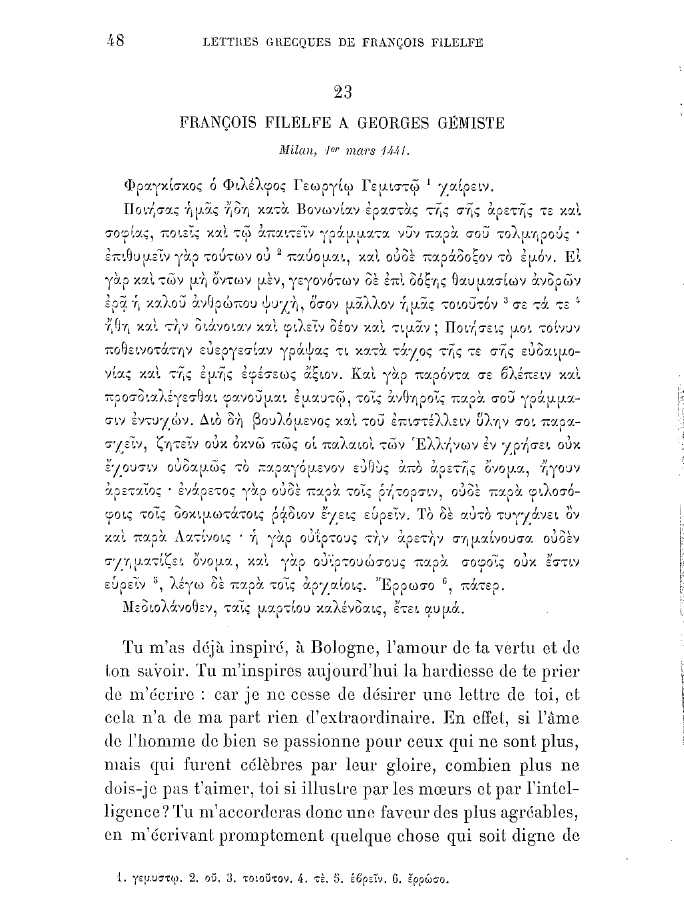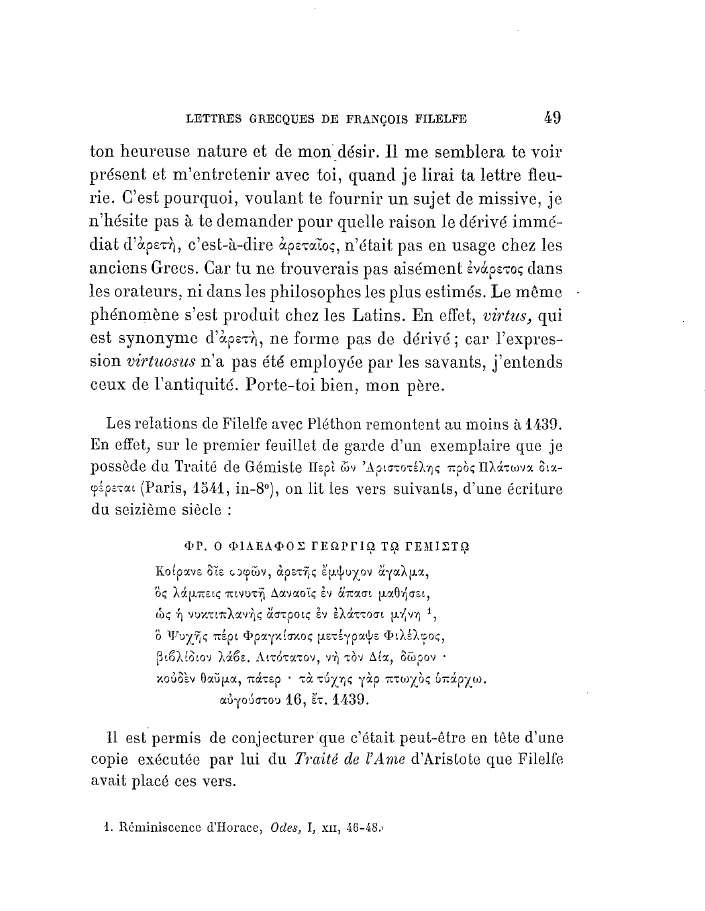Sorry I'm so late responding. I was otherwise engaged.
Let’s see. Ross gives us a letter by Filelfo to Plethon of March 1441:
Tu m'as dèja inspiré à Bologna, l'amour de ta vertu et de ton savoir. Tu m'inspires aujourd'hui la hardiesse de te prier de m'écrire: car je ne cesse de désirer une lettre de toi, et cela n'a de ma part rien d'extraordinaire. En effet, si l'âme de l'homme de bien se passionne pour ceux qui ne sont plus, mais qui furent célèbres par leur gloire, combien plus ne dois-je pas t'aimer, toi si illustre par les moeurs et par l'intelligence? Tu m'accorderas donc une faveur des plus agréables, en m'écrivant promptement quelque chose qui soit digne de ton heureuse nature et de mon désir. Il me semblera te voir présent et m'entretenir avec toi, quand je lirai ta lettre fleurie. C'est pourquoi, voulant te fournir un sujet de missive, je n'hésite pas à le demander pour quelle raison le dérivé immédiat d'arete, c'est-à-dire aretaios, n'était pas en usage chez les anciens Grecs. Car tu ne trouverais pas aisément enaretos dans les orateurs, ni dans les philosophes les plus estimés. Le même phénomène s'est produit chez les Latins. En effet, virtus, ui est synonyme d'arete, ne forme pas de dérivé; car l'expression virtuousus n'a pas été employée par les savants, j'entends ceux de l'antiquité. Porte-toi bien, mon père.
“You have already inspired me in Bologna, by the love of your virtue and your knowledge. You inspire in me today the impudence to ask you to write me: for I do not stop wishing a letter from you, and that is on my part nothing extraordinary. Indeed, if the soul of the good man longs for those who are no more, but who were famous for their glory, how much more must I not love you, so illustrious by your morals and your intelligence? You will thus accord me a most agreeable favor, by writing me quickly something that serves your happy nature and my desire. It will seem to me that I am seeing you present and am conversing with you, when I shall read your flowery letter. That is why, wanting to supply your letter a subject, I do not hesitate to ask for what reason the immediate derivative of
arete, that is to say
aretaios, was not used by the ancient Greeks. Because you would not easily find
enaretos in the orators, nor in the most esteemed philosophers. The same phenomenon occurred in Latin. Indeed,
virtus, which is synonymous with
arete, does not form a derivative; because the expression
virtuousus was not used by the scholars, as I understand those of antiquity. Take care, my father.”
Or something like that. In any case, Filelfo is not exactly deep in philosophical discussion. He praised Plethon’s opponent Scholarios as well, earlier. Woodhouse says of Filelfo, on one of the pages I reproduced
His indiscriminate praise of both Gemistos and Scholarios shows that he hardly understood the controversy between them. He was not qualified for profound speculation in metaphysics, though he was an important intermediary between Greek and Latin humanists. (p. 159,
http://2.bp.blogspot.com/-wuXdEap_k1k/Tk6-YQUgy-I/AAAAAAAADfE/smaZm2w763E/s1600/Woodhouse158.jpg)
Woodhouse’s conclusion doesn’t follow, unfortunately. Filelfo praised Scholarios in March 1439; then he learned more and praised Plethon in August. If he was still praising both by March of 1441, the date of the letter you (Ross) cited, that would show something. Still, I expect that Woodhouse is right.
I scanned the two pages from Woodhouse and put them on the Web because all I could find in Google Books was his first chapter. If anyone knows of more, I’d appreciate the link. The copy of the book that I was using is temporarily inaccessible to me.
I appreciate your careful dating of Plethon’s and Filelfo’s travels, Ross. Woodhouse didn’t actually say Filelfo met Plethon in August, just that it was “shortly” before August 16, but after the Greeks left Florence, “six months” from their arrival there in January. (So I said “around August,” meaning to include the end of July: but June 12 was earlier than I expected.) And Woodhouse didn’t base his statement that they met on the 1441 letter you cited. He based it on the epigram dated 16 August 1439. To decide whether Woodhouse is justified in inferring that there was a meeting between them, it would seem important to have a translation of the epigram, which Legrand didn’t provide. So yes, I think it would be helpful if you translated it sometime. I don’t know Greek (or Latin; the other languages I can decipher with the help of online translation machines).
So far, all we know is that Filelfo expressed great respect for Plethon, whether only from what he’d heard, or from reading
De Differentiis sometime after May 1439, or from reading something else, or from meeting him. In any case, he seems to have at least respected Plethon’s integrity and intelligence. It does not mean he embraced Plethon’s radical Neoplatonism. That part might have been of less interest to him.
So I have no idea how much Plethon's Neoplatonism influenced Filelfo; I would guess very little. But I don't think the question of Plethon's possible influence on the tarot is settled. As I said in this thread early on, I see no influence of Plethon in the Cary-Yale. As I have also said, I do see Platonism in the PMB Chariot card; but it didn't take Plethon or even Filelfo for that. There were also, for Plato in Visconti Milan, the Decembrios.
Also, I have no idea why Wikipedia says that Bonifacio Bembo was influenced by Plethon (
http://en.wikipedia.org/wiki/Bonifacio_Bembo). I looked in the only reference that article cited, an Italian dictionary of Italian art. I didn’t translate the entry on Bembo (p. 140) word for word, but it certainly doesn’t mention Plethon. As for how Bembo did a tarot deck “whose symbolism reflects his interest in Neoplatonism,” another claim in Wikipedia, I again have no idea, The Chariot card only requires a knowledge of one part of Plato’s
Phaedrus, a part already translated into Latin and well known. It seems to me that the "genius of the sun" idea was Aristotelian.
As to Plethon’s influence on the tarot, if any, it might have been sometime after 1460, when Cosimo finally organized his Academy and put the Orphic-hymn-singing Ficino in charge (he was only around five years old at the time of Plethon’s visit), and when the Roman academies or academy-like groups (e.g. Bessarion’s) were formed. It is then that Plethon's influence was the strongest, and also, shortly after, when it was the most actively repressed (by a certain pope). Among tarot decks, I don't see it where I would expect it, in decks associated with Florence. Instead, I would think of the Cary Sheet, which has some rather original imagery, and perhaps an odd card here and there from decks with only one or two surviving cards. Unfortunately, for whatever reason, there is a dearth of tarot examples for the 16th century. In the 17th century, the Noblet and “Chosson” seem to me the most promising candidates (descendants of the Cary Sheet). Just because Plethon didn’t influence the earliest tarot, doesn’t mean he didn’t influence the tarot at all. However this has to be discussed on a card by card level, and with a lot more knowledge of Plethon’s influence than I have.
I love speculating. But before I can speculate on Plethon’s influence or lack of it on the tarot, I have to know more about Plethon’s influence on Italian and other European thought of the times. I have to read more of Woodhouse and Hankins. And there is the material mentioned by Samten, if I can find any of it.



